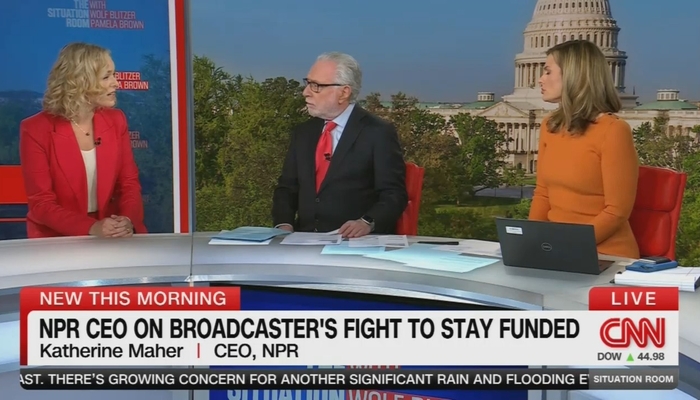


With $1 billion in taxpayer funding on the line as part of a rescission package the Senate could vote on late Wednesday, PBS and NPR have teamed with their liberal media allies to throw the proverbial kitchen sink at trying to maintain the farce of non-partisan, robust, and unique local programming that saves lives. That was the message Wednesday morning from NPR CEO Katherine Maher on CNN’s Situation Room.
Co-host Wolf Blitzer and Pamela Brown were more than happy to help Maher, openly rooting for NPR and, amid their softball questions, letting her spew lies about NPR’s biases, funding, and then vile smears about rural Americans.
Brown greased the skids in a fretful tease: “And just ahead, Wolf, PBS and NPR stations could soon lose the federal funding that’s helped keep them on the air for decades. We’re going to speak to the head of NPR up next.”
After a break, Blitzer cued up Maher by lamenting “NPR faces a fight for survival,” but cheered Senator Lisa Murkowski (R-AK) arguing the Corporation for Public Broadcasting — which oversees the entire public media cabal — shouldn’t be “gut[ted].”
Brown had the first question concerning their lobbying efforts:
Blitzer followed up by wondering if they’re focusing on any senator in particular. This triggered a putrid answer, steaming with coastal elitism and a venomous insult to rural Americans, viewing them like they’re pioneers stuck on the Oregon Trail:
Fact-check: 96 percent of Americans have regular internet access with adults 30-49 and 50-64 having 87 and 82 percent broadband use, respectively.
This led into an exchange in which Maher’s answer was riddled with bunker-buster-bomb-sized lies:
First, the claim about funding to local stations. Here’s what our Tim Graham wrote in February:
Public broadcasters claim the vast majority of their funding has nothing to do with government. Defenders of NPR claim the network only receives two percent of its money from Washington. That’s simply untrue. The vast majority of NPR stations receive “community service grants” from CPB, and then turn around and send money back to D.C. for “programming costs” for the nationally distributed shows.
If only two percent of the budget came from taxpayers, then logically, it would be easy to replace with private contributions. But CPB’s own chart of revenues for both TV and radio asserts that in Fiscal Year 2022 federal, state, and local “tax-based” funding added up to 36.6 percent. According to CPB’s math, federal funding in 2022 made up about $535 million (16.9 percent) and state and local funding was $589 million (18.7 percent).
Next, she said “it doesn’t help anyone.” Pew’s own polling showed only 20 percent of Americans listed PBS or NPR as a news source. And, as our buddy from the Ruthless Variety Progrum Leigh Wolf pointed out, the term “news desert” is a problematic term.
Then came a laugher: “As far as the accusations that we’re biased, I would stand up and say, please show me a story that concerns you, because we want to know and we want to bring that conversation back to our newsroom.”
Aside from checking out the public broadcasting tag at NewsBusters, consider facts such as June 2024 study that found “pro-Hamas” label was never used on PBS, a December 2024 study showing only 162 far-right labels vs. just six for the far-left on PBS, or a study last week showing 36 liberal guests on NPR’s Fresh Air vs. zero conservatives. Those examples don’t even delve into the day-to-day bias on PBS and NPR.
Blitzer went then to the fear and loathing side of the equation with Maher claiming “as many as 80 stations” would close and that NPR “would probably start by letting go of local journalists,” worsening “a crisis in local news in this country” since NPR “covers 99.7 percent”:
With NPR alone, our tally showed they have 1,085 stations with multiple stations in a market (e.g. Boston) whereas the largest private radio syndicate in the U.S. — iHeart — has 868 stations. Behind iHeart, competitors Audacy and Cumulus have roughly 230 and 404, respectively.
And, as we point out in the above video post from X, less than six percent of daily programming in rural states are local and we estimate nationally it’s been 90 and 100 percent either produced by NPR’s national team or major affiliates in Boston, Los Angeles, New York, Philadelphia, San Francisco, and Washington, D.C.
Speaking of those, Blitzer’s final question concerned the future of those large markets. Maher again gave a laughable answer:
WAMU being the only place to find out about changes in Washington’s metro system? Pants on fire. That’s all but saying The Washington Post, The Washington Times, Washington City Paper, ARLnow (Arlington County, Virginia), FFXnow (Fairfax County, Virginia), and local TV stations WDCW (CW), WJLA (ABC), WRC (NBC), WTTG (Fox), WUSA (CBS) to name a few don’t exist and cover the subway.
In fact, in a few cases, they have their own transportation reporter.
The interview closed with Blitzer openly making his position clear, personally arguing for NPR to remain funded:
At least Maher did not use the Texas Hill Country floods as an excuse.
To see the relevant CNN transcript from July 16, click here.
